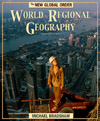Comparative Approach: The text continues to be essentially comparative. This is a UNIQUE feature of this text that no other gets near. Each regional chapter has a similar order: the region's place in the world; its cultural history; its natural environments; its subregions (distinctive features, people, economic development); its urban and rural landscapes; and its potential future. Each chapter has a similar set of maps and diagrams that always use the same scale. Maps are comparative (chapter opening "globes", relief, population distribution, land use) and are designed to be easily read by students. And the graph-type diagrams used are designed to be interesting, readable, and comparative (population and economic data). This makes comparisons from one world region to the next easy for students. As you review the chapters in the text, please note how easy it will be for students to learn the similarities and differences between the world regions due to the consistent presentation of material. Each regional chapter (3 to 11) follows a pattern that makes it straightforward to compare one region with another. Learning System: A textbook should be designed to help students make the most of their course. Several times in a chapter the information is summarized in RECAP sections that have been expanded to include critical thinking questions about that region, and a list of Key Terms and Key Places. At the end of every chapter are 30 Sample Test Questions that will help students review the chapter. Online Learning Center: This text-specific web site will provide you and your students with teaching and learning tools. You'll find interactive mapping exercises, animations, virtual field trips, and online quizzing. Additionally the Student Study Guide is located here at no cost to students! | 


 2002 McGraw-Hill Higher Education
2002 McGraw-Hill Higher Education